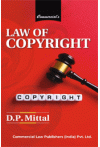- Author(s): D.P. Mittal
- Publisher: Commercial Law Publishers (India) Pvt Ltd
- Edition: Ed 2023
- ISBN 13 9789356031579
- Approx. Pages 718 + Contents
- Format Hardbound
- Approx. Product Size 24 x 16 cms
- Delivery Time 3-5 working days (within Kerala & South India) (Others 7-9 days)
- Shipping Charge Extra (see Shopping Cart)
............................................................................................
Description
What is worth copying is prima fcie worth protecting, such as, distinctiveness in case of trade mark, inventiveness in the case of patent, and originality in case of copyright. Copyright is exclusive right to use or reproduce a work of artistic or literary creativity, given by the law to creators of literary, dramatic, musical and artistic works and producers of cinematograph films and sound recordings. Unlike a trade mark, it is a right created under the Act-a monopoly in favour of the author. Copyright also creates a monopoly in favour of the copyright society in respect of broadcasting reproduction rights and performer's rights. The Copyright Act, 1957 was enacted with a view to amend and consolidate, the law relating to copyright, providing that no person shall be entitled to copyright or any similar right otherwise than under and in accordance with the provisions of the Act. The Act was amended seven times, since its enactment in 1957, once each in the years 1983, 1984, 1992, 1994, 1999, 2012 and 2021. The 1983 Amendments were primarily focused on compulsory licensing and manner of assignment of copyright. The 1984 Amendment addressed the piracy issue as piracy became a global problem due to the rapid advances in technology. The 1992 Amendment was essentially to protect the copyright of Gurudev Rabindra Nath Tagore. The 1994 Amendment was a major one which harmonized the provisions of the Copyright Act, 1957 with the Rome Convention, 1961 by providing protection to the rights of performers, producers of phonograms and broadcasting organizations. It also introduced the concept of registration of copyright societies for collective management of the rights in each category of copyright works. The amendment in 1999 introduced a few minor changes to comply with the obligations with the trade related aspects of Intellectual Property Rights (TRIPS). In 2012, the amendment was made with the object of making certain changes for clarity to remove operational
difficulties and also to address certain newer issues that have emerged in the context of digital technologies and the internet. It has addressed the rights of the Authors of literal and artistic works and also certain related rights which are the rights of the performers and phonograms.
.........................................................................................
Contents
Chapter 1 : Introduction
Chapter 2 : Copyright - Concept and Features
Chapter 3 : Subsistence of Copyright
Chapter 4 : Copyright - Exclusive Rights
Chapter 5 : Copyright - Cinematograph Films
Chapter 6 : Sound Recording
Chapter 7 : Ownership of Copyrights
Chapter 8 : Assignment, Transmission and Relinquishment
Chapter 9 : Compulsory and Statutory Licence
Chapter 10 : Copyright Societies
Chapter 11 : Copyright Society - Tariff scheme
Chapter 12 : Copyright Society - Administration of Rights of Owner
Chapter 13 : Copyright Society - Control of Authors
Chapter 14 : Copyright Society - Returns and Reports
Chapter 15 : Broadcasting Organisation and Performer Rights
Chapter 16 : International Copyright
Chapter 17 : Registration
Chapter 18 : Infringement
Chapter 19 : Remedies against Infringement
Chapter 20 : Groundless Threat
Chapter 21 : Offence and Penalty
Chapter 22 : Offences by Companies
Chapter 23 : Prosecution -,Cognizance of Offence
Chapter 24 : Quashing Criminal Proceedings
Chapter 25 : Appeal
Chapter 26 : Powers of Registrar
Chapter 27 : Protection of Action taken in good faith
Appendices
............................................................................................
Author Details
D.P. Mittal

